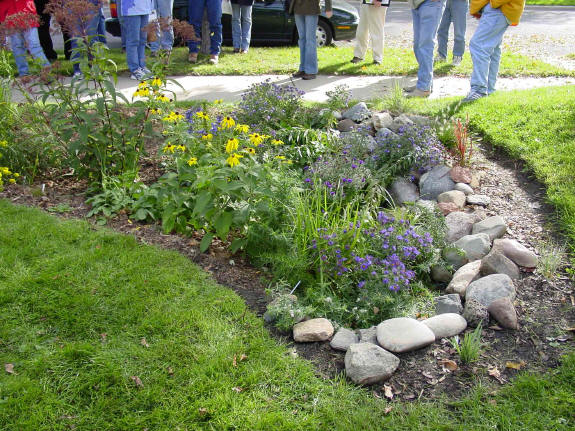Mary Ann Ryan
Adams County Master Gardener
 A rain garden is nothing more than a depression in your yard planted with native plants that collects water run-off from your roof, driveway or other hard surfaces. It acts as an infiltration system that keeps our
water out of the storm water system and on our properties, re-charging the ground water. Rain gardens reduce the amount of storm water that ends up in our streams and lakes, and helps to improve water quality by filtering through plants and the soil. Developing a rain garden gives us the opportunity to keep our water clean
and percolate through the soils.
A rain garden is nothing more than a depression in your yard planted with native plants that collects water run-off from your roof, driveway or other hard surfaces. It acts as an infiltration system that keeps our
water out of the storm water system and on our properties, re-charging the ground water. Rain gardens reduce the amount of storm water that ends up in our streams and lakes, and helps to improve water quality by filtering through plants and the soil. Developing a rain garden gives us the opportunity to keep our water clean
and percolate through the soils.
So what's wrong with stormwater? Stormwater is simply water that starts as clean rain that falls, runs off roofs and other hard surfaces like sidewalks and streets, picking up nutrients from the fertilizers we pump into our lawns, pet waste from our yards, salts from the roads, and other pollutants.
These pollutants, carried by this once clean rainwater, end up in our creeks and rivers, polluting our waterways, reducing the water life and health of our streams.

Developing a rain garden is an easy enough task. You want to choose the location carefully so you get the most benefit of a rain garden. Look for a low depression or low lying area that already exists in your yard. Be sure your garden is located at least 10 feet and down slope from your home or
building, so basement leakage doesn't become a problem. If you don't have a low spot, you can create one by digging a depression in your yard where water would naturally collect, or you can run your downspouts directly into your rain garden area.
Mix some compost into the existing soil. Remember the purpose is to filter water, so you want your soil to be good for plants so filtering can occur. A heavy clay soil will hold too much water, not allowing it to percolate into the soil, so be sure you know your soil type and add necessary
amendments.
When creating the depression, it is recommended to have about a six inch drop from grade. The depression should be flat on the bottom, thus allowing the water to be evenly distributed in the depressed area. The sides should have a slight slope. Remember, you are preparing the soil for plants. Having
loose, workable soil will not only benefit the plants, but will also allow for water to drain.
Choosing plants for your rain garden is lots of fun. A rain garden has three zones: wet, dry, and in-between. Know how quickly your garden is going to drain so you can appropriately plan on the types of plants to select. Typically, these gardens consist of native plants, although non-native,
non-invasive plants could be used as well.
The advantage of using native plants is that these plants are accustomed to growing in a given area, making them easy to grow and adapt. Be sure you choose the right plant for the right place. On the bottom of your depression, you should consider plants that can survive wet feet, as well as adapt to
dryer conditions as water drains in the garden, such as lobelia or ironweed. Also, if the rain garden is located in sun or shade, choose plants accordingly.
The sloped sides of the garden is your transition zone, thus a plant that can take conditions that may be wet for a short period of time is in order. Such plants may be clethra, chokeberry, or a perennial such as wood's aster.
The upper most part of the garden is the location that you will need to plan for plants that like it on the dry side. Such choices may be switch grass, coneflowers, or rudbeckia. Also remember when designing to consider the height of your plants and where the garden will be viewed from, so the
taller plants are to the rear and shorter to the foreground, or that the height of any of the plants does not conflict with visibility of parking or traffic.
Treat the rain garden as a garden. Weeding and mulching will be a necessity when getting the garden established. Expect to have lots of critters, from birds, butterflies and insects to chipmunks and rabbits, visiting your rain garden. Enjoy the garden and what life it brings while knowing that you
are doing your part in keeping our ground water recharged and our streams clean!
Read other articles on garden and landscape design
Read more
articles by Mary Ann Ryan